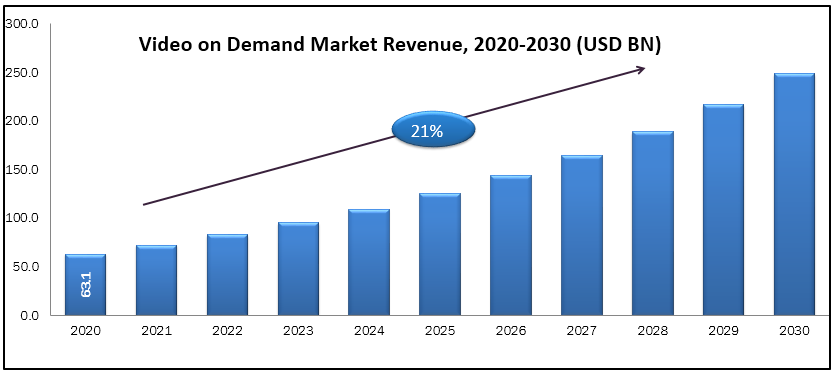Video On Demand Market accounted 63.08 USD billion in 2020 and is expected to reach 248.6 USD billion by 2030 growing with a CAGR of 14.7% during the forecast period.Video on demand (VoD) is a system that provided a video streaming and allows viewers to select and watch video content at convenient time along with display devices including smart TVs, tablets, smartphones, and others. The VoD providers transmit this content via real-time streaming protocol without a traditional video entertainment device and without the constraints of a typical static broadcasting schedule. These services transform via real-time streaming protocol by offering unique features such as high quality video and exclusive video content on demand of customers. It offers variety of video programs that include movie access, TV programs, and web series, live streaming of concerts or show, and music. Rakuten, Inc. announced the launch of new live streaming and VoD sports entertainment platform named Rakuten Sports which provided a significant growth in the VoD market size in June 2019. The main reason for watching video content is that it allows multiple users at the same place to watch different programs on various devices at the same time. The popularity of binge watching fuelled customer viewing experience. The widespread usage of mobile devices with increasing access to the internet has helped the customers to stay up-to-date with the digital world without waiting. The need for instant satisfaction is considered as a powerful source in the consumer world, where the users are adopting online platforms for their entertainment purpose.
Market Segmentation:
Based on solution, the global video on demand market is bifurcated into pay television (TV), (IPTV), and (OTT) Services. By pay TV, video on demand market is sub divided into cable TV and (DTH). Depending on business model, the market is categorised as subscription-based, advertising-based, transaction-based, and others. Based on application, the market is classified into entertainment, education & training, online commerce, digital, sports and others. Based on end user, the market is categorised into healthcare, manufacturing, academia & government, consumer goods & retail, hospitality & tourism, telecommunications & IT, & entertainment, transport & logistics, (BFSI), and others. By the region, video on demand market is segmented into North America, Europe, Asia Pacific, and RoW.
Market Dynamics and Factors:
The convenience of accessing video anywhere at any time, higher proliferation of smart devices, high-speed connectivity, and affordability is one of the major drivers for the growth of the global video on demand market. Moreover, rise in need to gain high number of customer base and to reach audiences on multiple devices, multimedia are some of the other factors which will drive the video on demand market. However, the difficulty in achieving negotiable content licensing due to piracy issues is responsible to restrain the market. Moreover, a compatibility with next generation devices, enhanced viewer engagement and payment systems are creating immense opportunities for the video on demand market growth during forecast timeframe. Further, the telecommunication industry is enhancing the product development and launching marketing strategy to provide exquisite customer experience to consumers across the population, which is expected to fuel the growth of the video on demand market during the forecast timeframe. The combination of on-demand content with live streaming events is considered to be the challenge for video on demand market.
Geographic Analysis:
Asia pacific have highest global video on demand market with culturally and economically diversified users who have varying content consumption patterns, content, and payment demands and also expected to leading market during the forecast period. China and Japan are the two major countries contributing significantly for boosting the market by the emergence of advanced technologies (5G and 4G). North America is accounted as second highest video on demand market share across the growth of video on demand market. The consumption of media content is increasing tremendously with switching from traditional media to digital media. The increasing internet speeds coupling with the increasing number of devices that provide the consumers with the freedom to access media content anywhere and anytime are other factors which fuelling the market in the U.S. region. Additionally, Europe is expected to be the fastest growing region for the market due to increasing use of smart devices with internet connectivity. Latin America and the MEA region are projected to witness substantial growth due to development of technology, developed payment infrastructure, and a dynamic local content ecosystem over the upcoming years.
Competitive Scenario:
The key players of global video on demand industry are Netflix, Amazon, Google, YouTube, Apple, HBO, Cisco, IndieFlix, Vudu, Hulu, Comcast, Akamai, Huawei, and Fujitsu.
Video On Demand Market Report Scope
| Report Attribute | Details |
| Analysis Period | 2020–2030 |
| Base Year | 2021 |
| Forecast Period | 2022–2030 |
| Market Size Estimation | Billion (USD) |
| Growth Rate (CAGR%) | 14.7 % |
|
| By Solution (Pay Television (Cable TV And Direct To Home Services (DTH)), Internet Protocol Television (IPTV), And Over-The-Top (OTT) Services), By Business Model (Subscription Based, Advertising Based, Transaction Based, And Others), By Application (Entertainment, Education & Training, Online Commerce, Digital, Sports And Others), By End User (Healthcare, Manufacturing, Academia & Government, Consumer Goods & Retail, Hospitality & Tourism, Telecommunications |
| Geographical Segmentation | North America (U.S., Canada, Mexico) Europe (UK, Germany, Italy, France, Rest of Europe), Asia-Pacific (China, Japan, India, Australia, Rest of APAC), South America (Brazil, Argentina, Rest of SA), MEA (UAE, Saudi Arabia, South Africa) |
| Key Companies Profiled | Netflix, Amazon, Google, YouTube, Apple, HBO, Cisco, IndieFlix, Vudu, Hulu, Comcast, Akamai, Huawei, and Fujitsu. |







